|
BULB LOG 29 20th July 2005
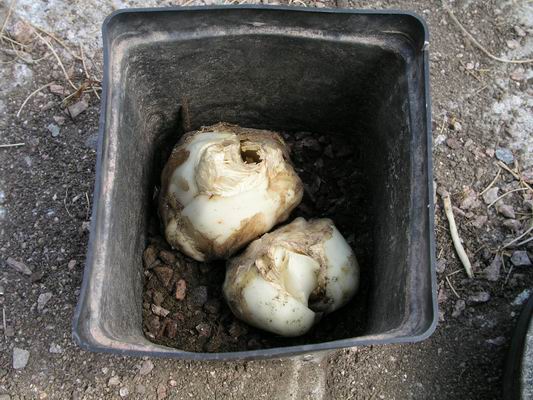
Fritillaria persica bulbs
Two Fritillaria persica bulbs are all I can fit into this 13 cm pot. It is a big plant to grow in a pot but we cannot rely on it being hardy and flowering regularly in our garden and climate. I said that I would come back to the changes that I would have to make to my regime as I am going over to growing more bulbs in square plastic pots. Firstly the reason for the change is that it is a much more efficient use of the space - the square pots fit tightly together so I can fit more into our glasshouses. I was thinking that I was well behind with my repotting because I have so many still to do but then I realised that I was looking towards the finishing line, if I looked at how many I have already done then I am well up with the task it is just that there is more to do every year as we continually add to our collection. It is said that you could get locked up for speaking to your plants, I do not speak to my plants but they speak to me - they try and tell me all I need to know about how to grow them I only have
to interpret their instructions.
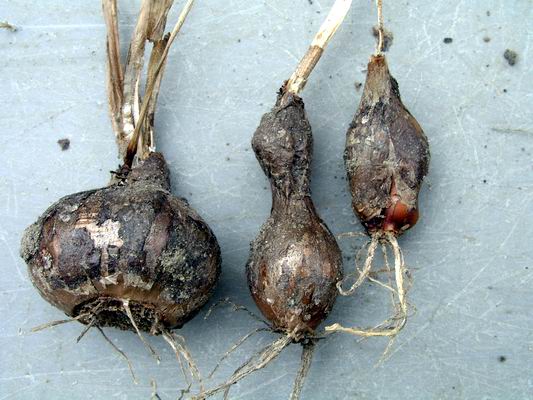
Narcissus bulbs
So what are these bulbs telling me? The large spherical one to the left is perfectly happy while the other two were not planted deep enough - their elongated shape is their way of getting deeper. As a basic rule Narcissus romieuxii, rupicola and their close relatives should be planted at half depth in plastic pots while others, N. bulbicodium, jonquilla and their allies need to be planted deeper -add ¼ to 1/3 compost then the bulbs.
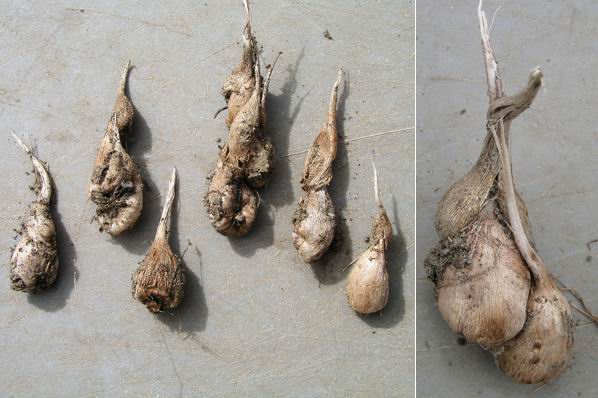
Crocus cartwrightianus
A similar signal is being sent by these Crocus cartwrightianus corms which are also exhibiting an elongated form.
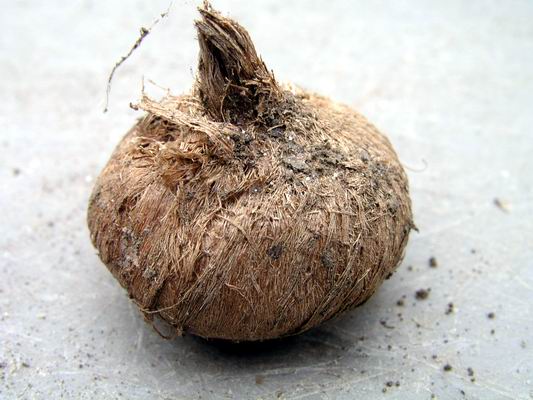
Crocus niveus corm
This Crocus niveus corm is a perfect shape indicating that I got its depth of planting right. What a wonderful thick coat it wears to protect it from excessive drying out in the hot dry summer that it would experience in the wild. If a crocus has a thick coat it generally indicates that it comes from a hotter drier environment than one with a slim coat. We must interpret this and make sure that Crocus with thick coats are kept dry in summer and those with thin coats such as C vallicola, banaticus etc should be kept just moist - again the plants are talking to us, we just have to listen.
During the switch over towards plastic pots I have been making many observations and making small adjustments to take into account the difference between plastic and clay. Although I am making a big shift this year I have been working towards it for several years. The main thing to note is that the compost in plastic pots stays wet much longer than it would in clay pots. Clay pots lose a lot of moisture in evaporation and so need watering more frequently. Evaporation causes heat loss (latent heat of evaporation) so plastic pots are often warmer. Because plastic hold onto water longer, this may cause problems when the spring weather is wet and cold like we experienced this year. I have now worked out that I only need to give plastic pots about 1/3rd of the amount water that I would give clay pots. The 'Autumn Storms' remain unchanged but I keep a careful eye on things and only water when I know it is necessary. As I am watering less frequently there is less opportunity to apply supplementary feeding such as po
tash so I have to be sure that I get it on quickly in the winter when the plant requires it. The other critical time is when the flowers are fading; the bulbs are using much less water so I have to take that into account, in cool weather many do not need any more water directly into the plastic pot after the flowers have gone over or when the seed capsule is fully expended. I do not want you to think that I always get it right; I also kill bulbs but never think it is a failure as long as I have learnt the reason behind the demise of the bulbs. The most common cause for bulb death is too much moisture especially as the dormant period is approaching, the other common fault is too little moisture when the bulb is coming out of dormancy and wanting to make roots. There are, of course, many other factors and one that always comes to my mind is the age of a bulb. Do bulbs have a finite life or can they and their vegetative offspring go on indefinitely? Surely when a bulb forms an offset that offset has to be the sa
me age as the parent bulb, it is not like seed raised bulbs which are young, vigorous and bouncing with health. - this is why I keep raising from seed.
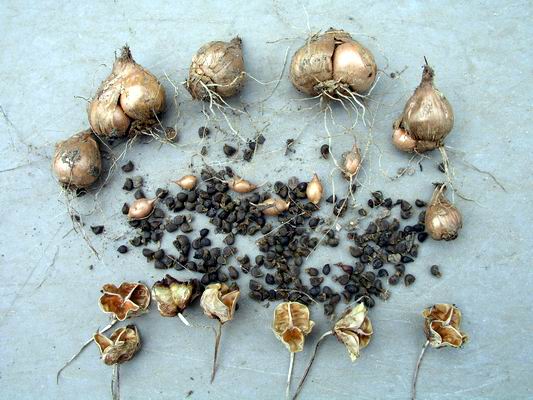
Crocus caspius seed and corms
I only found the seed of this Crocus caspius when I tipped it out to repot because the seed capsules were completely underground. This was a nice bonus as I have only ever had a small pinch of seed on this plant before and this in our worst year for seed production since we started growing bulbs. It is no coincidence that this is one of the Crocus pots that we took into the kitchen to enjoy the flowers and that heat in the critical few days while the pollen was flowing has resulted in this gift from nature.
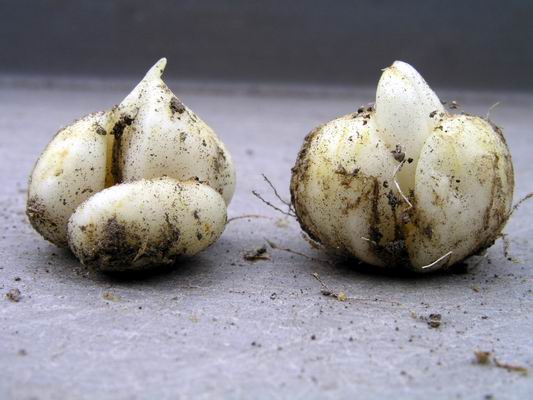
Fritillaria collina
Only two bulbs of Fritillaria collina in this pot, grown from wild collected seed: it is still a scarce plant. I think that they should be big enough to produce their first flowers next spring.
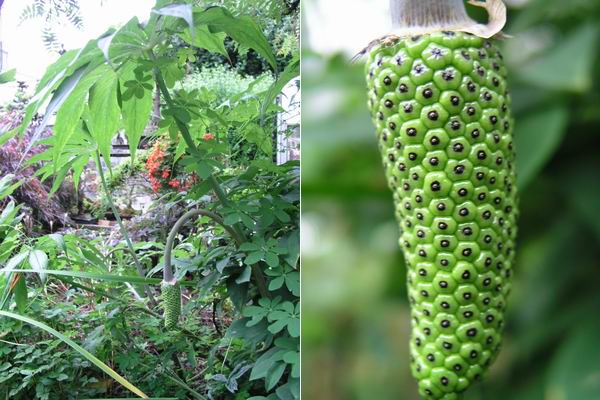
Arisaema seed head
Many of the arisaemas turn their flower stem downwards or through right angles when the seed has been fertilised - this can be seen in this Arisaema ciliatum seed head.
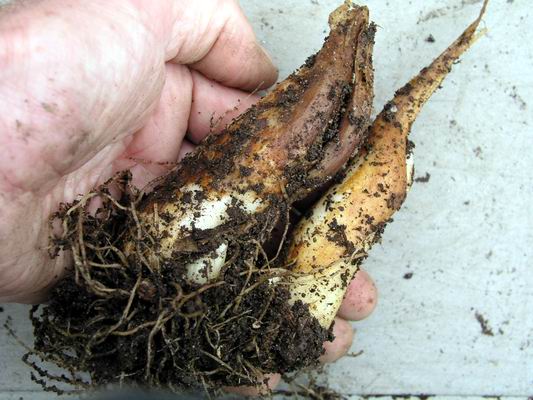
Erythronium Susannah bulbs
The bulbs of some erythroniums like 'Susannah' the hybrid between tuolumnense and oregonum, can get very large.
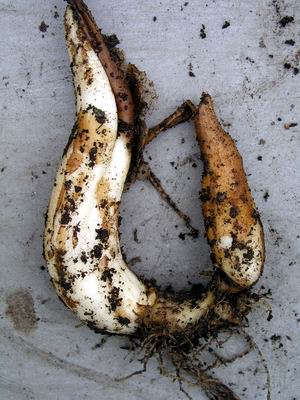
Erythronium Susannah offset bulb
Erythronium 'Susannah' makes offset bulbs: generally one sizable one and it is interesting to see how it forms from the base.

Codonopsis cariophylla
While not strictly a bulb, the codonopsis do have a swollen over-wintering root and they are in full flower just now. You can always tell when they have started into growth because they emit a strong foxy smell whenever their foliage is disturbed. I must remember to collect the seed as we do not have so many as we once had and they give a good show of flowers in the summer months.
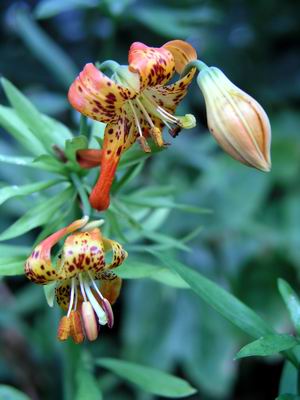
Lilium pardalinum
A couple of lilies to finish off this week's log; first from Oregon, Lilium pardalinum and below from Japan, Lilium medeoloides.

Lilium medeoloides
^ back to the top ^
|

